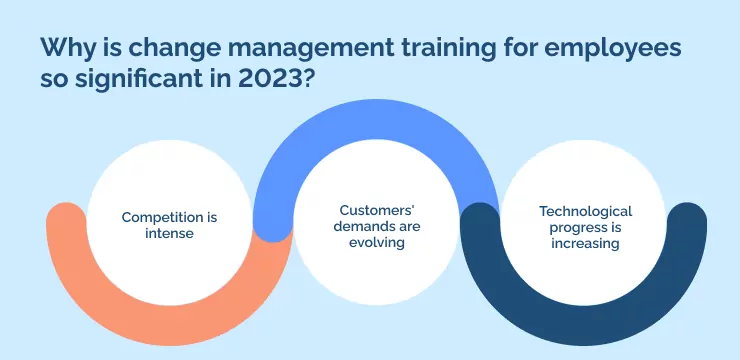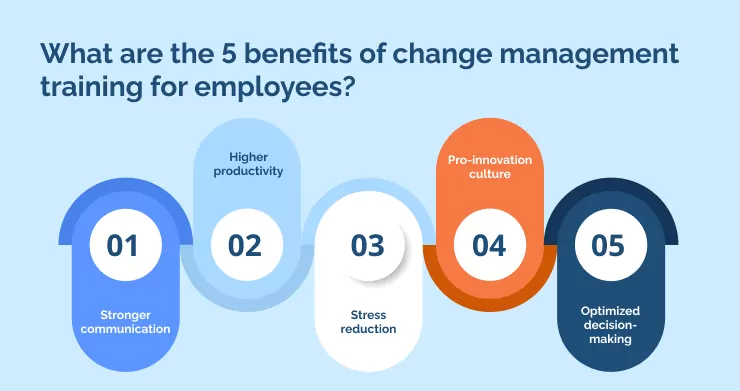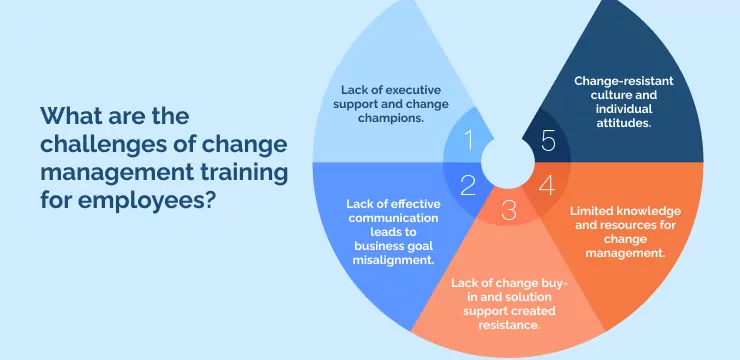
You’ve read it a hundred times before, but it’s still true, so here we go… change is the only constant!
This fact is the main driver for why change management training for employees is so significant in 2023 – if your staff aren’t prepared for the changes new digital developments can bring, your business will suffer.
Predictions tell us that global spending on digital transformation for businesses will reach USD 3.4 billion by 2026, which is a lot of change management courses!
This statistic shows how investment matches the fast pace of change organizations need to remain competitive and how staff need to be resilient to change, requiring employee change management training.
Because of the clear need for change management training for employees, we will explain everything you need to know via the following topics:
- Why is change management training for employees so significant in 2023?
- What are the 5 benefits of change management training for employees?
- What are the challenges of change management training for employees?
- What are the 6 steps of change management training for employees?
- How will change management training for employees look in the future?
Why is change management training for employees so significant in 2023?

In 2023 the pace of change is faster than ever, which makes an overwhelming scenario for your workforce unless you step in with change management training.
There are three reasons for the breakneck speed of digital transformation today, and the pressures this places on organizations to invest and support their staff so they can retain them.
- Competition is intense
- Customers’ demands are evolving
- Technological progress is increasing
C-suites plan how their organization will invest and implement these new changes, but who will implement them?
Team members in lower-level roles. And these are the ones holding up the organization’s weight and success on their shoulders. If they don’t receive support, they will crumble, and the organization will fall.
Change management training ensures that staff can stand tall and remain resilient to changes, dodging the punches of digital transformation and remaining an integral part of their organization as they embrace change.
What are the 5 benefits of change management training for employees?

Look out for these benefits as you begin your employee change management training.
1. Stronger communication
Employees who are kept in the loop about new organizational changes will communicate better with colleagues.
2. Higher productivity
Employees can only follow a plan if their manager or a C-suite communicates it clearly, allowing them to work productively.
3. Stress reduction
If you manage change poorly, it will lead to uncertainty, doubt, and resentment and can result in mass resignations. Well-planned change management training provides clarity and structure, which minimizes stress.
4. Pro-innovation culture
When employees see the benefits to their role in change, they become confident in suggesting and implementing innovative ideas to improve processes to increase efficiency, resilience to change, and growth while reducing waste.
5. Optimized decision-making
A straightforward and systematic decision-making process supports staff to feel coordinated, promoting focus and collaboration.
If you implement change management training for employees correctly you will enjoy all these benefits as your staff’s well-being increases and your business respondss positively to market changes.
What are the challenges of change management training for employees?

Before you enjoy the benefits of employee change management training, you must tackle the many challenges which can cause change programs to fail. These include:
- Lack of executive support and change champions.
- Lack of effective communication leads to business goal misalignment.
- Lack of change buy-in and solution support created resistance.
- Limited knowledge and resources for change management.
- Change-resistant culture and individual attitudes.
Be aware of these challenges to ensure you tackle them directly to ensure success.
What are the 6 steps of change management training for employees?

Now, let’s be clear. There is a vast difference between the training for change management leaders to help them qualify for certifications and the training for employees who often have no say in the changes their organization is implementing.
The fact that many employees will feel a lack of control and agency in digital transformation decisions is what you need to consider as the core of your change management training to ensure success.
1. Define change management training needs
Determining the specific changes you want and whether the resulting knowledge, skills, or behavior changes will benefit your organization is essential.
Collect data and other relevant information to assess if a new technology platform or significant changes are needed to achieve your goals. Refrain from sharing your ideas with your employees until you are confident that the change is required.
Next, effectively adapt and build relevant skills; providing change management training to employees is essential.
You can achieve this by conducting a readiness assessment for employees and their managers/supervisors. The survey helps to identify pain areas and strategies for managing change.
2. Utilize clear communication
One of the main obstacles to successful change management is the lack of information about upcoming transitions. As employees play a crucial role in the success of any organizational change, these transitions will directly affect their attitudes and behaviors.
When you implement the change management training program, it’s essential to develop communication and messaging methods that evolve.
After establishing the context, the next messaging step should focus on building awareness and the necessary skills and behaviors that the workforce must adopt.
Tailor messaging based on the recipient’s role and preferences, rather than a generalized approach, and consider the best timing and the choice of communication channels.
3. Choose the right change management training solutions
Organizations must invest regularly in training and development programs to keep up with the rapid changes in the world economy and business landscape. Training should be a continuous process instead of a one-time event.
A DAP (Digital Adoption Platform) is an excellent tool for helping your staff learn change management strategies involving in-app guidance and personalized learning. It reduces employee resistance to change as they choose their training modules and manage their learning.
It also frees up change management leaders to focus on other staff who have more complex queries or need more demanding support, as a DAP does not require traditional classroom learning as it allows learners to understand how to manage change as part of ongoing training.
Online change management programs are an affordable option, enabling employees to take the training at their own pace and on the device of their preference. By using online training, employees can avoid the stress of falling behind on work or delaying their responsibilities.
These training solutions offer the benefit of packaging programs using various attractive digital media, which helps learners to engage with the course content better. You can also save on logistics and related costs while offering your staff the convenience and flexibility of self-paced learning.
4. Be actively empathetic
Understanding and acknowledging your employees’ concerns and offering support as they adjust to new technologies and workflows is essential to successful change management training programs.
Although you may hold a senior position and have the power to impose changes, forcing your employees to adapt without empathy will likely lead to resentment and negatively impact their performance.
Gain the trust and support of team members during times of change, as it’s essential to listen to and address their concerns instead of forcing your actions.
By helping them in a way that is meaningful to them, you will be able to guide them through the transitions successfully.
Remember that humans have free will, so it’s essential to consider their perspectives.
5. Promote collaboration
Practical change management training of employees involves them throughout the change process. Doing so prevents them from being startled by the change and makes them more inclined to participate in the transition as they know the business strategies behind the reasons for changes.
Additionally, incorporating their viewpoints, perceptions, and inputs could improve the transition. When employees participate in developing the change management process, they are more likely to embrace and implement the changes.
And finally, it’s essential to ensure excellent management support so that pressure on team managers doesn’t negatively impact the learning program.
6. Define roles and responsibilities
It’s essential to clearly define everyone’s roles and responsibilities, including those of the employees in change management.
In addition, designating who will oversee and monitor the changes will prevent confusion and frustration among people who otherwise lack clear guidance and directions.
How will change management training for employees look in the future?
Change management is about preparing staff for constant changes by helping them embrace the fluctuating nature of business. Looking to the future is essential to supporting your team to achieve this.
VR/AR
VR and AR are already becoming a large part of the training processes for many enterprises.
Imagine how effective it could be to allow employees to experience new software in a more immersive, engaging way to help them see its benefits to them and their organization.
ChatGPT
Chat support bots can answer staff questions about how a change program will operate and help them develop independent ideas on becoming more digitally resilient, supporting them to embrace change.
Personalized training
Training will be more personalized in the future, but staff will have control over what aspects of change management they would like to learn next based on their role and use a system to track their training.
Use a DAP to start at the bottom to see success at the top
Change can be daunting for any business, but you can achieve it successfully with the right tools, resources, and training.
A DAP should form the core of your training management training program, as it allows users to learn on their terms and in their own time.
By fostering an open dialogue between employees and employers, change management training prepares them to meet current challenges while readying them for future growth.
As the saying goes, ‘Start at the bottom to see success at the top.’
Employers should recognize this as a critical opportunity to get their team on board with upcoming changes while enhancing engagement. Investing in change management training is essential in navigating your organization through transformation.
Tristan Ovington
Tristan Ovington is a professional senior writer and journalist, specializing in providing expert insights on various topics such as digital adoption, digital transformation, change management, and Cloud apps. He delivers his knowledge through accessible online content that is data-driven and presented in a friendly tone, making it easy for readers to understand and implement.



